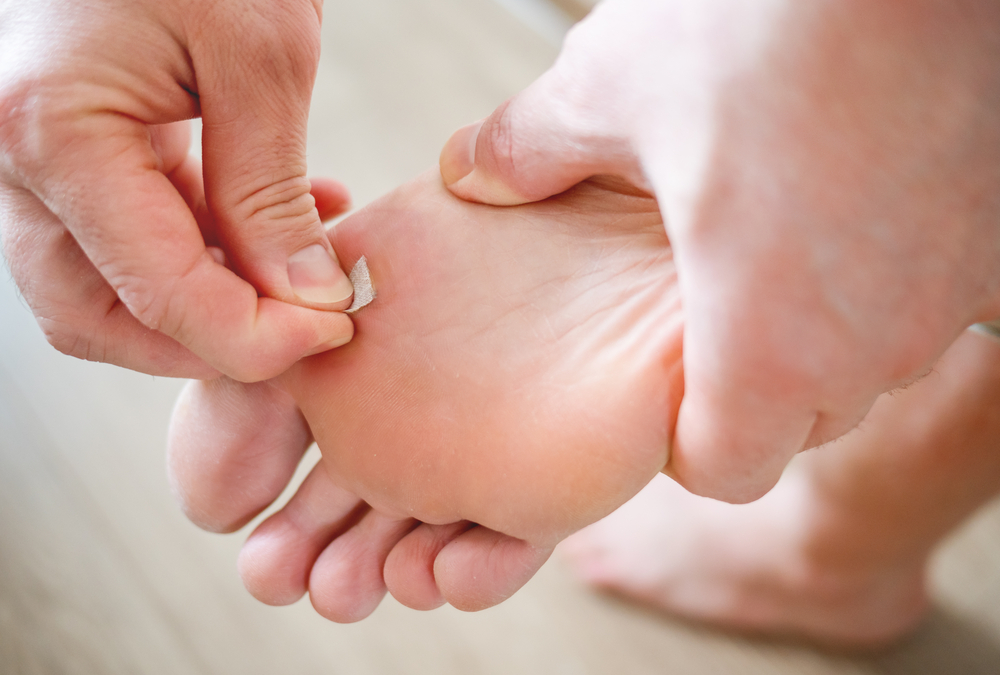A plantar wart is a growth on the bottom of your foot caused by the Human Papilloma Virus (HPV). It is usually circular or oval in appearance, and there might be just one or several. Because the foot bears a lot of pressure, the wart might start to grow inwards instead of outwards, which can cause pain. Warts sometimes go away on their own, especially in children, but you can contact a Kelowna, BC or Victoria, BC foot specialist if you’re concerned.
At the clinic, we can diagnose your condition and help you find a treatment that will speed up your recovery and remove the wart permanently. That way, you don’t have to spend several months using over-the-counter creams and ointments that might not be very effective. Today, we’ll have a closer look at some of the treatments we might suggest and how they get rid of warts.
What’s the Best Way to Get Rid of a Plantar Wart?
There are several ways of removing warts from the feet, and the best one depends on your individual situation. When you first come to the clinic, we will have a look at your foot. If necessary, we will scrape the top layer off your wart to check for tiny, clotted blood vessels, which are an indication of warts. Depending on your condition, we might also send a small section of your skin to a lab so we can determine whether HPV is causing your infection.
Treating warts isn’t usually very difficult, and most people make a full recovery. Those who have only had warts for a short time or who only have a few might benefit from freezing medicine, called cryotherapy, or peeling medicine. However, patients who have very deep and stubborn warts should consider surgery or a combination of methods.
Freezing Medicine
One of the most common and successful wart treatments is cryotherapy. It involves applying liquid nitrogen to the affected area, either with a cotton swab or a spray. The freezing medicine causes the formation of a blister around the wart, which falls off together with the wart within a week. Additionally, the freezing can stimulate the immune system and help the body fight off the infection.
Although one treatment can be effective, many patients have to return to the clinic several times to have their warts frozen off. Each time, your doctor might apply numbing cream to the area to make sure the liquid nitrogen doesn’t hurt when it is applied. After three to four treatments, up to 70% of your warts should have disappeared.
Peeling Medicine
Sometimes, a prescription-strength medication is used to peel off the wart one layer at a time. This drug contains salicylic acid, which gets absorbed into the skin and peels off the cells that are infected by the HPV. In some cases, the medicine can also boost your immune system and therefore help you defeat the pathogens that are causing your warts.
If your doctor has prescribed salicylic acid, it’s likely that they will show you how to use it at home. You will be able to administer this medicine yourself, but you might need to visit the clinic for periodic checkups to make sure the warts are disappearing. Usually, salicylic acid is applied in the evening before bed, and you should cover your foot with a sock or bandage to make sure the medicine stays in place until the morning.
Surgery
Often, the two methods above are enough to get rid of warts on the feet, but sometimes, patients have to have a minor surgical procedure to fully remove the growths. If cryotherapy and salicylic acid didn’t work, your foot doctor might suggest destroying the warts with an electric needle and then cutting them away. This treatment is minimally invasive, so you won’t have to be anesthetized or spend time at a hospital.
However, your skin will be numbed, so you won’t feel pain during the procedure. The appointment should take around 60 minutes, and you’ll only need to come to the clinic once. Most patients will be able to return to their regular activities the next day, but this depends on the depth of the incision and the number of warts that have been removed.
Immune Therapy
Since many warts are caused by the Human Papilloma Virus, your immune system can fight them by killing the pathogen. Sometimes, immune therapy is the most effective way of addressing this condition. You might be given a solution or cream to apply to your warts, or you might be injected with medication or a solution that can strengthen your immune system.
Laser Treatment
Laser treatment is an alternative to cryotherapy, and it works by applying heat, not cold, to your wart. The laser will burn the blood vessels in the affected tissue, and over time, the dead cells will fall off. Laser treatment has to be repeated every two to four weeks until the warts have been removed completely. Like with many of the other treatments, your skin will be numbed at the start of the session.
Blistering Medicine
Cantharidin is a type of medicine that forms a blister under the wart. Over time, this will cause the plantar wart to fall off. This medicine is not available over-the-counter, so you will have to speak to your Kelowna, BC or Victoria, BC doctor about it. About a week after treatment, you might need to return to your clinic to have the wart clipped off.
When Should I Go See My Kelowna, BC or Victoria, BC Doctor?
Not everyone with a wart on their foot has to go to the doctor immediately. Sometimes, the condition resolves itself, especially if the patient is still a child or if they have had the HPV vaccine. However, you should speak to a professional if the wart is affecting your day-to-day life and causing you pain.
You should also come to the clinic if the wart suddenly changes shape, if it starts bleeding, or if you’re not sure whether your growth truly is a wart. People with a weakened immune system and those who have diabetes and therefore have poor feeling in their feet shouldn’t hesitate to reach out.
How Can I Prevent Warts in the Future?
Once you’ve had your wart removed by a doctor, you’ll want to make sure that the condition doesn’t recur. To prevent another infection, you should limit your chances of contracting HPV. Don’t touch other people’s warts, and always wear flip flops or sandals when visiting shared facilities such as public showers or swimming pools.
Always keep your feet and hands clean and dry. If you use tools such as a nail clipper on your warts, always wash them thoroughly or use different ones on your healthy tissues to avoid spreading the infection from one area of your body to another.
A plantar wart isn’t usually a serious condition, but it can be annoying and sometimes painful, especially if it grows inwards or starts bleeding. At the clinic, we can use several treatment methods to get rid of warts, including cryotherapy, prescription medication, and minor surgery. Send us a message now at Island Foot Clinics in Kelowna, BC or Victoria, BC to find out more about our foot centers or to book your first appointment.

